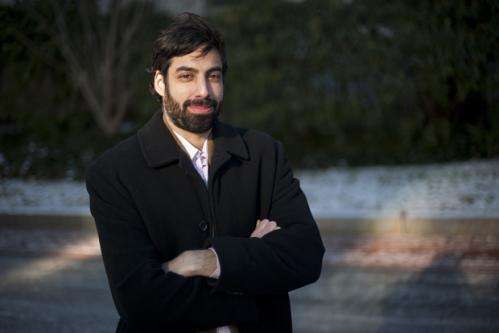'Driving' a new pair of arms: Neurology, recovery and rehabilitation

Brendan Marrocco, an Iraq War veteran who lost all four limbs in a roadside bomb attack, was recently released from a Baltimore hospital after receiving a double-arm transplant. Northeastern University news office asked Christopher Hasson, a sensorimotor control expert and a newly appointed assistant professor in the Department of Physical Therapy, to explain the brain's role in the long recovery and rehabilitation process.
Marrocco received the double-arm transplant six weeks ago and has already reported movement in the elbow of his left arm. What is the brain's role in learning how to control a novel object, which in this case is a new pair of arms?
A human arm is marvelously complex—and presents a formidable control problem for the brain. The scale of this problem is best illustrated by comparison with driving a car. With an automatic transmission you have three things to control: The steering wheel turns the car left or right, the gas pedal speeds up the car, and the brake slows it down. Healthy adults learn the basics of driving relatively quickly, but fine-tuning takes much longer and can only be achieved through many hours of practice. During this fine-tuning process the brain refines its knowledge of how the car responds to control actions. In Marrocco's case, he must learn to "drive" his new arms; however, the control problem explodes in complexity. For each arm he must learn to control motions at three joints with 12 muscles; if you include the hand that adds at least 14 more joints and more than 20 more muscles. Imagine trying to learn to drive a car with more than 30 different controls! Fortunately, Marrocco has a head start, as he has had prior experience controlling arms. This may explain why he learned to perform basic movements relatively quickly. However, fine-tuning his control will take much longer.
You are the principal investigator of Northeastern's Neuromotor Systems Laboratory, in which you study how movement control in older adults is affected by age-related changes in the neuromuscular system. How will Marrocco's relative youth—he is only 26 years old—contribute to the recovery and rehabilitation process?
Although it's natural to think that a relatively young adult such as Marrocco would have a clear advantage over someone who is older, age may not be a critical factor in terms of the motor learning aspects of recovery. It was once widely thought that after you reach adulthood the structure of your brain stabilizes and becomes fixed, and therefore older adults would have difficulty learning new skills as their brains are more resistant to change.
However, recent studies have shown that the brain remains malleable into old age, and that older adults can often learn new tasks just as well as younger individuals, although they may move more slowly. Of course, there are still advantages to being young. For example, as you age, the volume and quality of brain tissue declines, which may have detrimental effects on movement control. In addition, older adults tend to use more of their brain's resources to perform motor tasks. This increased cognitive effort may make an older adult fatigue more easily than a young adult like Marrocco, giving him an advantage in the rehabilitation process. There are many open questions about how aging affects motor learning and control. Adults 65 and older who wish to participate in my lab's research on aging can contact neuromotorsystemslab@neu.edu for more information.
Marrocco says he looks forward to driving, swimming, and competing in a marathon using a handcycle. Given that the nerves in his arms will regenerate at a rate of only one inch per month, how do you foresee his recovery process unfolding? Will he ever regain enough motor control of his arms to be independent?
The time it takes to regenerate the nerves within the arm will limit the pace of recovery. Marrocco won't be able to perform some movements until his nervous system can properly "talk" to all of his muscles. There will also be a multitude of changes in the brain, which is constantly reorganizing its structure in response to changes in behavior, the environment, and in Marrocco's case, to injury. This malleability is called neuroplasticity. After Marrocco lost his arms, the regions in the brain that are responsible for arm sensation and control probably shrunk as a result of disuse, but these regions should expand as he regains control of his arms. It is critical that Marrocco keeps trying to use his new arms, as this will drive neuroplasticity. Every time Marrocco performs an action the associated neural connections will strengthen. Ideally, Marrocco will enter a cycle of positive feedback: neuroplasticity will enable him to do more with his arms, which should motivate him to perform more actions, which will further reinforce connections in his brain.
















